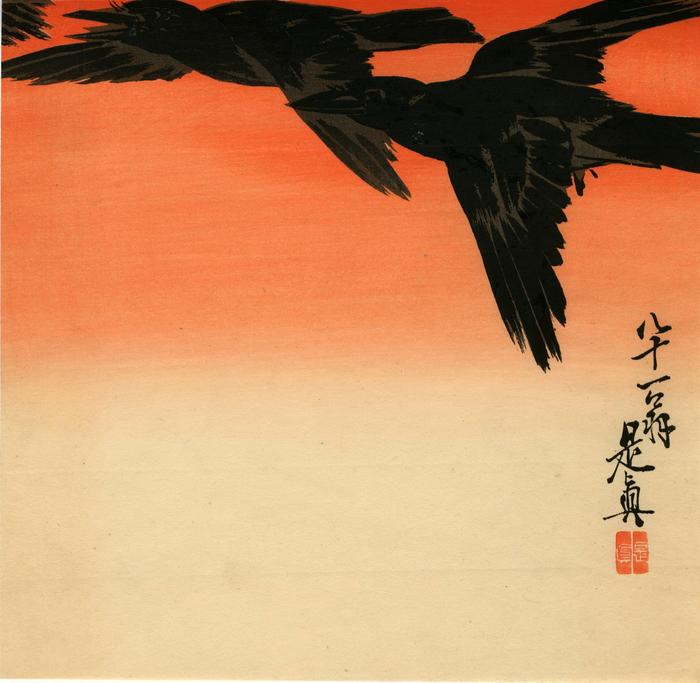Shibata Zeshin (柴田是眞) (artist 1807 – 1891)
Crows flying at sunrise
1887
9.5 in x 9.25 in (Overall dimensions) woodblock print
Signed: Eighty-one year old Zeshin
(Hachijuissae Zeshin)
八十一歳是眞
Artist's seal: Zeshin
Achenbach Foundation for Graphic Arts
Minneapolis Institute of Arts
Museum für angewandte Kunst, Vienna
The National Museum of Asian Art
Muzeum Sztuki i Techniki Japońskiej Manggha, Krakow
Brooklyn Museum
Rijksmuseum
Art Gallery of Greater Victoria
New York Public Library
Honolulu Museum of Art
Smart Museum of Art, the University of Chicago - dated ca. 1884 In a fascinating and informative article in Andon from December, 2013 cited below Robert Schaap, made a number of important points, not only about this design, but about the representation of crows in East Asian art in general. He noted of this design that: "One of the highlights of Meiji period (1868-1912) printmaking is without doubt Zeshin's print of crows flying across the sky in the red glow of a rising sun. The birds are depicted in the upper segment of the print partly running off the paper - a composition more often encountered in Zeshin's designs - whereas the lower part is empty. " Later he added: "Note that of the crows on the right, the beak of the leÍt one is open and that of the right one is closed. This detail derives from a rule stating that in every painting there should be a contrast (active and passive, Iight and shade... [etc.]"
Schaap also makes it clear that there were quite a few variations in the treatment of the sky of this print. Some are early editions and some are posthumous.
****
"Three crows are flying against a red sky. The subject of crows against a rising sun was a popular one in the Meiji era. It was treated by both Kōson and Zeshin, as well as by Zeshin's arch-rival Kyōsai. Crows in Japan are often associated with the sun, as a three-legged crow who lives in the sun was thought to cause sunspots. The extreme popularity of this theme in Meiji times, however, seems to point to the other, more nationalistic reasons, perhaps related to the role of the crow as a messenger of the Gods and a symbol of the first emperor of Japan...
The reddish sky, an effect achieved by bokashi (wiping the blocks after inking), differs from print to print."
Quoted from: The Age of Yoshitoshi: Japanese prints from the Meiji and Taishō periods..., this is Part V of the Catalogue of the Collection of Japanese Prints of the Rijksmuseum, Amsterdam.
****
"Compared to his lacquerware and painting, Zeshin produced relatively few prints... [He] began to include his age in signatures on work done after his late 60s."
Quoted from: The New Wave: Twentieth-century Japanese prints from the Robert O. Muller Collection, p. 78.
The Muller archives indicate that this print was published by Daikokuya.
****
Illustrated:
1) in Ukiyo-e: The Art of the Japanese Print by Frederick Harris, Tuttle Publishing, 2010, fig. 168. Harris dates this print to 1888.
2) in a color reproduction in The Art of Japanese Prints by Richard Illing, Octopus Publishing, 1980, p. 159.
3) in color in The Legacy of Japanese Printmaking/Le Rayonnement de l'estampe Japonaise by Barry Till, the Art Gallery of Victoria, 1986, pl. #V.
4) in black and white in Imperial Japan: The Art of the Meiji Era (1868-1912) by Frederick Baekeland, Herbert F. Johnson Museum of Art, Cornell University, 1980, p. 145.
5) in a small black and white reproduction in Catalogue of the Collection of Japanese Prints Part V - The Age of Yoshitoshi, Rijksprentkabinet/Rijksmuseum, 1990, no. 11, p. 13.
6) in color in "Zeshin's 'Crows in flight at sunrise': The anatomy of a print" by Robert Schaap in Andon 95, December, 2013, fig. 9, p. 35.
7) in color in The New Wave: Twentieth-century Japanese prints from the Robert O. Muller Collection, Bamboo Publishing, Ltd. and Hotei Publishing, 1993, page 78, no. 33.
****
The original publication of this print appeared in 1888. While the publisher seal is not present it is most likely Matsuki Heikichi. Late editions continued until at least the 1920s to 1930s. This is considered by many to be Zeshin's most famous print.
****
There is another copy of this print in the collection of the Art Gallery of Greater Victoria.
modern prints (shin hanga - 新版画) (genre)
kachō-e (bird and flower picture - 花鳥絵) (genre)
Meiji era (明治時代: 1868-1912) (genre)
Daikokuya Heikichi (大黒屋平吉) (publisher)
